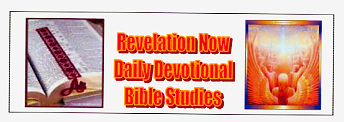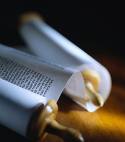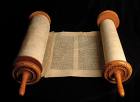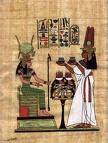
| Next | Previous | Index | Tellout Home |
23. Seven-Sealed Scroll
Revelation 5.1-5
"Then I saw in the right hand of him who sat on the throne a scroll with writing on both sides and sealed with seven seals. And I saw a mighty angel proclaiming in a loud voice, 'Who is worthy to break the seals and open the scroll?' But no one in heaven or earth or under the earth could open the scroll or even look inside. I wept and wept because there was no one found worthy. Then one of the elders said to me, 'Do not weep! See, the Lion of Judah's tribe, David's Root, has triumphed. He can open the scroll and its seven seals.'" (Revelation 5.1-5) ✞
Dead Sea Scrolls
 John of Patmos sees a similar vision to what he had most likely read in Ezekiel 2.9-10. "Then I looked, and I saw a hand stretched out to me. In it was a scroll, which he unrolled before me. On both sides were written words of grief, mourning, and woe." The seven-sealed scroll in God's hand is a scroll and not a book. This form is similar to the Dead Sea Scrolls from BC 300, which shepherds discovered in pots in 11 high desert caves above the Dead Sea's north shore in 1946 and 1947. In the ancient world, down to the second century AD, the writing was generally on rolls, not books. Calfskin was called "vellum," and other animal hide materials were called "parchment." Pieces were sewn up, rolled, and sealed with clay or wax. "The scroll" was usually made in ten by eight-inch sheets. The sewn-together leaves formed a long roll on a wooden roller protruding at the top and bottom for easy reading. Revelation's seven-sealed scroll contained this Biblical book's entire text. Scholars tell us that the papyrus scroll writing would have been in narrow columns about 3 inches wide, with margins of about 2 1/2 inches at the top and at the bottom, with about 3/4 inch between columns. A reader held a scroll in the left hand, unrolled with the right, and as the reading proceeded, rotated the left-hand roller to take up the slack. ✞
John of Patmos sees a similar vision to what he had most likely read in Ezekiel 2.9-10. "Then I looked, and I saw a hand stretched out to me. In it was a scroll, which he unrolled before me. On both sides were written words of grief, mourning, and woe." The seven-sealed scroll in God's hand is a scroll and not a book. This form is similar to the Dead Sea Scrolls from BC 300, which shepherds discovered in pots in 11 high desert caves above the Dead Sea's north shore in 1946 and 1947. In the ancient world, down to the second century AD, the writing was generally on rolls, not books. Calfskin was called "vellum," and other animal hide materials were called "parchment." Pieces were sewn up, rolled, and sealed with clay or wax. "The scroll" was usually made in ten by eight-inch sheets. The sewn-together leaves formed a long roll on a wooden roller protruding at the top and bottom for easy reading. Revelation's seven-sealed scroll contained this Biblical book's entire text. Scholars tell us that the papyrus scroll writing would have been in narrow columns about 3 inches wide, with margins of about 2 1/2 inches at the top and at the bottom, with about 3/4 inch between columns. A reader held a scroll in the left hand, unrolled with the right, and as the reading proceeded, rotated the left-hand roller to take up the slack. ✞
Fifteen Feet Long
 We can get some idea of the Revelation papyrus scroll's dimensions from the Scottish scholar Dr. William Barclay (1907-1978). He wrote, "The Second and Third John, Jude and Philemon Epistles would occupy one papyrus sheet each. The Romans' Letter would require an 11 1/2 feet long roll. Mark's Gospel was about 19 feet, John's about 23 feet, and Matthew's about 30 feet long. The combined Luke and Acts' roll would be about 32 feet long. The Revelation scroll would take up about 15 feet." ✞
We can get some idea of the Revelation papyrus scroll's dimensions from the Scottish scholar Dr. William Barclay (1907-1978). He wrote, "The Second and Third John, Jude and Philemon Epistles would occupy one papyrus sheet each. The Romans' Letter would require an 11 1/2 feet long roll. Mark's Gospel was about 19 feet, John's about 23 feet, and Matthew's about 30 feet long. The combined Luke and Acts' roll would be about 32 feet long. The Revelation scroll would take up about 15 feet." ✞
Papyrus Production
 Workshops produced papyrus from River Nile delta bulrushes. Each bulrush grew up to fifteen feet high, six feet below the water and its stem sometimes as thick as a man's wrist. It is used in sheets throughout the ancient Mediterranean world for writing or painting and making rope, sandals, and boats. The pith for the papyrus writing scrolls was extracted and cut into thin strips with a very sharp knife. They laid each papyrus strip row vertically, and on top, another row horizontally. It was then moistened with water, glued, and pressed together. The word "Papyrus" is the origin of the English word "paper," but the paper itself was said to have been invented around 105 AD by the Han court eunuch named "Cai Lun" (48-121 AD.) The earliest surviving fragments of paper come from 2nd century China. He made paper after watching wasps building paper-like nests. Around 2000 BC, the Babylonians placed papyrus documents in baked clay envelopes, which survive today! Workers beat papyrus with a mallet and then smoothed it with a pumice stone to produce a sheet, not unlike brown paper. In Egypt, locals sell tourists beautifully colored papyrus souvenirs like bookmarks and drawings of hieroglyphic writing and tomb paintings. On a trip to Egypt some years ago, my wife bought several beautiful tourist papyri displayed in our home today. ✞
Workshops produced papyrus from River Nile delta bulrushes. Each bulrush grew up to fifteen feet high, six feet below the water and its stem sometimes as thick as a man's wrist. It is used in sheets throughout the ancient Mediterranean world for writing or painting and making rope, sandals, and boats. The pith for the papyrus writing scrolls was extracted and cut into thin strips with a very sharp knife. They laid each papyrus strip row vertically, and on top, another row horizontally. It was then moistened with water, glued, and pressed together. The word "Papyrus" is the origin of the English word "paper," but the paper itself was said to have been invented around 105 AD by the Han court eunuch named "Cai Lun" (48-121 AD.) The earliest surviving fragments of paper come from 2nd century China. He made paper after watching wasps building paper-like nests. Around 2000 BC, the Babylonians placed papyrus documents in baked clay envelopes, which survive today! Workers beat papyrus with a mallet and then smoothed it with a pumice stone to produce a sheet, not unlike brown paper. In Egypt, locals sell tourists beautifully colored papyrus souvenirs like bookmarks and drawings of hieroglyphic writing and tomb paintings. On a trip to Egypt some years ago, my wife bought several beautiful tourist papyri displayed in our home today. ✞
Scroll Writing
 Revelation's papyrus writing scroll, according to Revelation 5.1, had "writing on both sides" to maximize the available space. One side where the papyrus grain ran horizontally was known as the "recto." It was easier to write on that side along the fibers' lines. The vertical fibers' side was called the "verso." Writers did not commonly use the verso side except in exceptional circumstances. Papyrus was expensive and very valuable in its day. So, if a person had a great deal to say, they probably used, as in the Revelation scroll, "writing on both sides." People wrote in both directions on the front and back of papyrus to save space. For the same reason, British prisoners of war in Japan wrote on both sides of toilet paper sheets! Some Victorians even wrote love letters in both diagonal directions as well! ✞
Revelation's papyrus writing scroll, according to Revelation 5.1, had "writing on both sides" to maximize the available space. One side where the papyrus grain ran horizontally was known as the "recto." It was easier to write on that side along the fibers' lines. The vertical fibers' side was called the "verso." Writers did not commonly use the verso side except in exceptional circumstances. Papyrus was expensive and very valuable in its day. So, if a person had a great deal to say, they probably used, as in the Revelation scroll, "writing on both sides." People wrote in both directions on the front and back of papyrus to save space. For the same reason, British prisoners of war in Japan wrote on both sides of toilet paper sheets! Some Victorians even wrote love letters in both diagonal directions as well! ✞
Wills
 The right hand of the one who sat on the throne held the seven-sealed scroll. As the seals opened, events unfolded. Seven seals joined up the Revelation scroll's parts. In Daniel 12.4, the prophet, on God's orders, closed and sealed his book. "But thou, O Daniel, shut up the words, and seal the book, even to the end time." On completion, scrolls were tied with threads and a seal, called a "sphragida," applied with wax or clay at the seven knots. Of the ten occurrences in the New Testament of this word meaning "seal," eight are in Revelation and two elsewhere. In each case, it translated as "a seal," "a seal of righteousness," "a seal of God," or "chained." Romans 4.11 reads, "And he received circumcision as a sign, a seal of the righteousness that he had by faith while he was still uncircumcised." 2 Timothy 2.9 says, "This is my Gospel, for which I am suffering even to the point of being chained like a criminal. But God's word is not sealed." Each seal had a different impression in the wax, probably bearing the witness' identity. Revelation's seven seals, like ordinary documents such as wills, often had several seals. Important kings sometimes have seven ribbons and wax seals on their testaments like Revelation. I remember seeing King Henry the Eighth's petition to the Pope for divorce and noted many impressed wax seals of lords and dignitaries, both large and small, attached to it. Revelation's seven-sealed scroll, however, contained secret information known only to God. The Lamb was the only one found worthy to break the wax seals and look at its contents. Under Roman law, witnesses sealed it and can only open it when their legal representatives are present. Revelation's scroll was God's will, his final settlement of universal affairs. The "seven seals" indicate its contents' great secrecy, completeness, importance and set out the conditions under which they could open it. The seven seals were located throughout the scroll so that as they broke each one, another phase of God's plan unfolded. Then as they read more of the manuscript, it revealed other steps towards the end of the age. ✞
The right hand of the one who sat on the throne held the seven-sealed scroll. As the seals opened, events unfolded. Seven seals joined up the Revelation scroll's parts. In Daniel 12.4, the prophet, on God's orders, closed and sealed his book. "But thou, O Daniel, shut up the words, and seal the book, even to the end time." On completion, scrolls were tied with threads and a seal, called a "sphragida," applied with wax or clay at the seven knots. Of the ten occurrences in the New Testament of this word meaning "seal," eight are in Revelation and two elsewhere. In each case, it translated as "a seal," "a seal of righteousness," "a seal of God," or "chained." Romans 4.11 reads, "And he received circumcision as a sign, a seal of the righteousness that he had by faith while he was still uncircumcised." 2 Timothy 2.9 says, "This is my Gospel, for which I am suffering even to the point of being chained like a criminal. But God's word is not sealed." Each seal had a different impression in the wax, probably bearing the witness' identity. Revelation's seven seals, like ordinary documents such as wills, often had several seals. Important kings sometimes have seven ribbons and wax seals on their testaments like Revelation. I remember seeing King Henry the Eighth's petition to the Pope for divorce and noted many impressed wax seals of lords and dignitaries, both large and small, attached to it. Revelation's seven-sealed scroll, however, contained secret information known only to God. The Lamb was the only one found worthy to break the wax seals and look at its contents. Under Roman law, witnesses sealed it and can only open it when their legal representatives are present. Revelation's scroll was God's will, his final settlement of universal affairs. The "seven seals" indicate its contents' great secrecy, completeness, importance and set out the conditions under which they could open it. The seven seals were located throughout the scroll so that as they broke each one, another phase of God's plan unfolded. Then as they read more of the manuscript, it revealed other steps towards the end of the age. ✞
Lion of Judah
 The "Lion of Judah's tribe" is a title for Jesus, who alone can open the seven-sealed scroll. "Judah's Lion" was also a title for King David. "A mighty angel," asked, "who is worthy to open the scroll?" There was despair at first when no one in creation could do it. But John of Patmos was comforted by an elder who told him that Christ earned the right to open the scroll. "The Lion of Judah's tribe" seemed to originate as an ancient "Messianic" title in Genesis 49.9. When Jacob blessed his sons, he said to one, "You are a lion's cub, Judah." In Revelation, "the Lion" is the conquering King Jesus. "David's Root" here refers to Jesus being from David's bloodline, thus fulfilling the Old Testament's Messianic promise. Isaiah 11.1-3a explains, "A shoot will come up from Jesse's stump, from his roots, a branch will bear fruit. Jesus Christ is "the Lion" descended from Judah's ancient kings. Judah's Lion will lead the battle and finally defeat Satan with his ancestors' authority and power. The Lion of Judah will then be the supreme victor! ✞
The "Lion of Judah's tribe" is a title for Jesus, who alone can open the seven-sealed scroll. "Judah's Lion" was also a title for King David. "A mighty angel," asked, "who is worthy to open the scroll?" There was despair at first when no one in creation could do it. But John of Patmos was comforted by an elder who told him that Christ earned the right to open the scroll. "The Lion of Judah's tribe" seemed to originate as an ancient "Messianic" title in Genesis 49.9. When Jacob blessed his sons, he said to one, "You are a lion's cub, Judah." In Revelation, "the Lion" is the conquering King Jesus. "David's Root" here refers to Jesus being from David's bloodline, thus fulfilling the Old Testament's Messianic promise. Isaiah 11.1-3a explains, "A shoot will come up from Jesse's stump, from his roots, a branch will bear fruit. Jesus Christ is "the Lion" descended from Judah's ancient kings. Judah's Lion will lead the battle and finally defeat Satan with his ancestors' authority and power. The Lion of Judah will then be the supreme victor! ✞
"Seven-Sealed Scroll"
by Ron Meacock © 2021
| ^Top Page | Next | Previous |